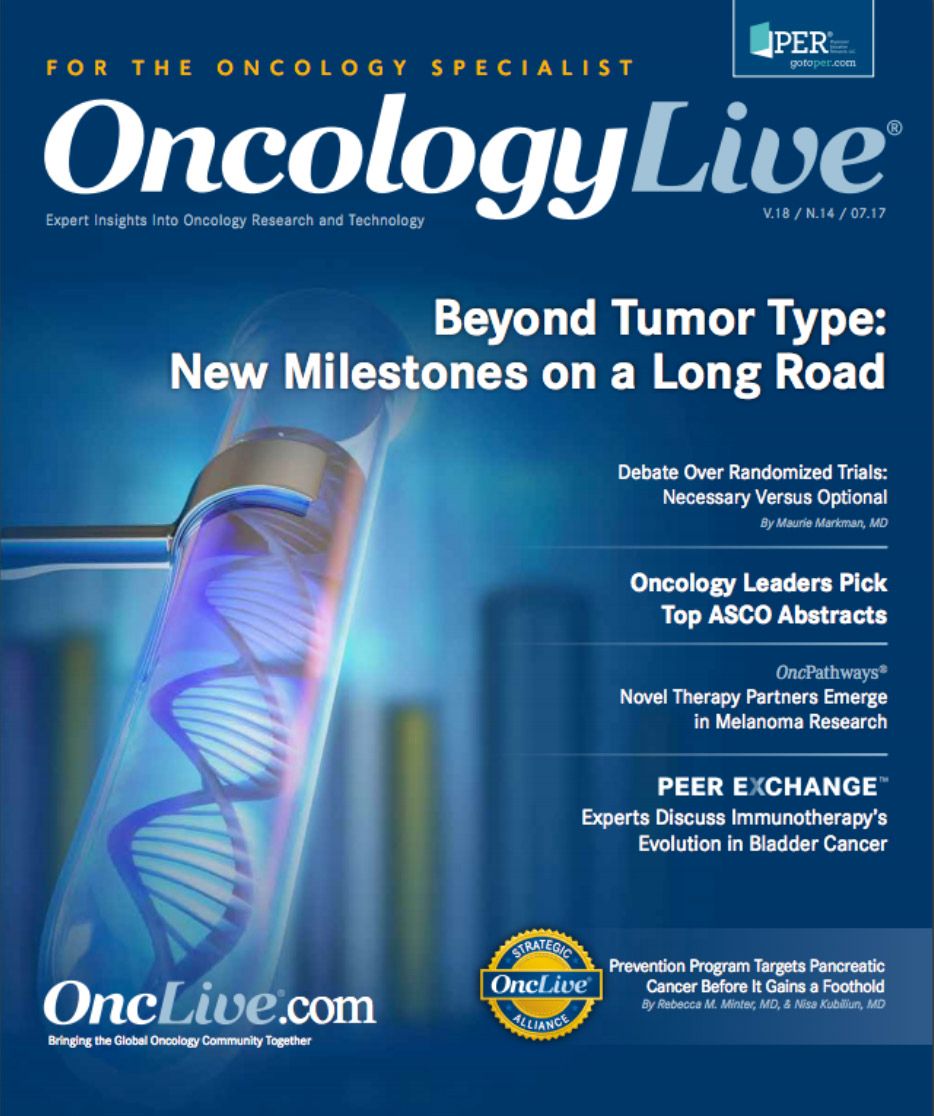Publication
Article
Oncology Live®
Experts Discuss Immunotherapy's Evolution in Bladder Cancer
Author(s):
The explosion of new checkpoint immunotherapy drugs has changed the paradigm of care for patients with urothelial carcinoma, the most common form of bladder cancer.
Daniel P. Petrylak, MD

Daniel P. Petrylak, MD
The explosion of new checkpoint immunotherapy drugs has changed the paradigm of care for patients with urothelial carcinoma, the most common form of bladder cancer, according to experts who participated in a recent OncLive® Peer Exchange® panel. Although chemotherapy regimens may still be the best first-line approach for some patients, other patients may benefit more from a checkpoint inhibitor.
Since May 2016, the FDA has approved 5 immunotherapy agents for patients with urothelial carcinoma: avelumab (Bavencio), atezolizumab (Tecentriq), durvalumab (Imfinzi), nivolumab (Opdivo), and pembrolizumab (Keytruda). The drugs, which are all PD-1 or PD-L1 inhibitors, have all been approved for patients with locally advanced or metastatic urothelial carcinoma that has progressed during or after platinum-containing chemotherapy, including within 12 months of neoadjuvant or adjuvant treatment. Atezolizumab and pembrolizumab also are indicated for patients who are not eligible for cisplatin-containing chemotherapy. Other checkpoint inhibitors that inhibit PD-1/PDL-1 or cytotoxic T-lymphocyte—associated antigen-4 (CTLA-4) have also shown activity in urothelial carcinoma.1
Heterogeneity of Bladder Cancer
Peer Exchange® moderator Daniel P. Petrylak, MD, and other experts in the field of genitourinary oncology discussed how immunotherapy is changing outcomes for patients with advanced bladder cancer.“Bladder cancer is a very heterogeneous disease, even within the metastatic state,” Petrylak said. Bladder cancers are broadly described as papillary or nonpapillary.2 Dean F. Bajorin, MD, explained that they are further subdivided into 3 main categories: metastatic bladder cancer, muscle-invasive bladder cancer (MIBC) without metastasis, and nonmuscle-invasive bladder cancer (ie, carcinoma in situ). The 3 types occur with different frequencies and require different management approaches.
Genomic studies like The Cancer Genome Atlas (TCGA) project have revealed numerous molecular subtypes and genetic signatures within the 3 main categories of bladder cancer.2 Bajorin said, “We know that there are a substantial number of mutations that we see in this disease. In fact, the mutation rate is right up there, with non—small cell lung cancer and melanoma.” He said the tumor’s genetic makeup appears to evolve over time. As a result, Bajorin said, metastatic bladder cancer has the highest prevalence of genetic mutations and “is poised for sensitivity to immune therapy.”
Elizabeth R. Plimack, MD, said multiple studies support a correlation between higher mutation load and greater likelihood of treatment response in bladder cancer. Plimack said she and colleagues investigated DNA repair genes in MIBC and found that “tumors with the highest number of alterations [had] the best response to cisplatin.”3 On the immunotherapy side, Rosenberg et al found that a higher mutational load predicted a good response to atezolizumab.4 Plimack said more data are needed to determine whether those likely to respond well to cisplatin and those likely to immunotherapy are the same people.
Patients with bladder cancer are also heterogeneous, and tend to be older. Bajorin said choice of treatment currently depends on the patient’s disease state and performance status. On one end, Bajorin said, “there are patients who are so-called good risk—that is, nodal-only disease, good performance status—and then at the other end of the spectrum are the patients who do very poorly, those who have visceral disease and have a poor performance status.”
“From a societal perspective, 10% to 15% of all bladder cancers in the United States don’t get treated at all,” said Robert Dreicer, MD. He said 1 reason many patients with advanced bladder cancer never receive treatment is because of tolerability issues with cisplatin, which forms the backbone of first-line chemotherapy. Thus, identifying a biomarker predictive of response to cisplatin would not render more patients eligible for chemotherapy.
The Checkpoint Landscape
David I. Quinn, MBBS, PhD, said everyone “would love a marker where we send it off [and] it comes back and says, ‘Look, this marker links to therapy X; please follow the dots,’” but he acknowledged that it is not that simple. “The disease state matters, as to whether the patient is eligible for chemotherapy as first-line,” he said“Aggressive bladder cancers are challenging to treat and, until the recent availability of checkpoint inhibitors, patients with progression of metastatic disease platinum-based therapy had few options,” Petrylak said. The FDA approvals of all 5 PD-1/ PD-L1 checkpoint agents were based on positive clinical trial data. The panel discussed the safety and efficacy outcomes for each drug in detail.
Dreicer said that although only 20% to 25% of patients typically respond to the checkpoint inhibitors, he has observed responses in patients he typically would have referred to hospice. “Having these drugs is a paradigm shift,” he said.
Arjun V. Balar, MD, who was involved in several clinical trials for checkpoint inhibitors, said some of the outcomes were striking. According to Balar, a small percentage of patients in a firstline trial of atezolizumab had complete responses, and the median overall survival (OS) was a surprising 15.9 months.5
“The impressive thing is the durability,” Petrylak said. He added that median duration of response has not been reached in several first- and secondline trials. Petrylak said although OS outcomes have been impressive, “progression-free survival is really fairly short with most of these studies— about 2 to 3 months.”
PD-L1 Expression
Plimack noted that PD-1/PD-L1 inhibitors appeared to have similar efficacy outcomes, with similar response rates and duration of response in the second-line trials. “They all interfere with the same pathway, and I think it shouldn’t be a surprise that we see some consistency of data across these data sets,” she said. “There’s very little, really, to differentiate them in terms of efficacy, in my view,” Plimack concludedMost of the clinical trials analyzed whether PD-L1 expression predicts response to checkpoint inhibitors of PD-1/PD-L1, but Petrylak said results were inconsistent. Quinn said one reason for the conflicting data is because PD-L1 expression changes over time, whereas the studies obtain a snapshot of the tumor in time. He said that snapshot may have been collected “the day before we want to start therapy or within a week, or it could be from a cystectomy or nephroureterectomy that was done 7 years before, and they’re likely to be very different.” Balar said the IMvigor-210 trial of atezolizumab in advanced bladder cancer showed some correlation between PD-L1 expression and response.4
He said approximately 28% of people who had the highest levels of PD-L1 expression responded to atezolizumab, compared with 8% to 10% of people who had the lowest level of PD-L1 expression. “Clearly, the message here is that even though there is a correlation with PD-L1 expression and response, having the lowest level of PD-L1 expression did not preclude response,” Balar said. He added that some PD-L1—negative patients had complete responses.
Safety Considerations
The panel seemed to agree that the data suggest some correlation between PD-L1 expression and outcomes but that PD-L1 was not likely to be the answer in the quest for a reliable biomarker to predict checkpoint inhibitor response. Several members expressed concern that PD-L1 expression could be used to deny patients access to a PD-1/ PD-L1 inhibitor.Bajorin said between 5% and 10% of patients in clinical trials of checkpoint inhibitors develop immune-related adverse events (AEs). He said the most concerning toxicities are pneumonitis and colitis, which can have a subtle onset but progress quickly. “There are clear-cut paradigms for intervention in terms of grade of toxicity…and I would highly recommend that treating physicians really become very familiar with those,” he said. urothelial carcinoma.
Other frequent immune-related AEs are fatigue and hypothyroidism; less frequent ones are adrenal insufficiency and pan-hypopituitarism. Bajorin recommended that physicians maintain a heightened awareness of all the possible immune-related AEs. He also emphasized the need to educate patients thoroughly and repeatedly. “Our nurses speak with our patients about what to call in about. Even though it may seem subtle to them, we really want to know about it,” he said. urothelial carcinoma.
Balar said he has found it easier to predict which patients will have a difficult time with chemotherapy than with immunotherapy. Petrylak said it is critical to determine whether patients have any comorbid autoimmune disorders that a checkpoint inhibitor might exacerbate. urothelial carcinoma.
Although many checkpoint inhibitors are approved for melanoma and are being studied for urothelial carcinoma, Quinn cautioned against combining a CTLA-4 inhibitor approved for melanoma with a PD-1/PD-L1 inhibitor approved for urothelial carcinoma.
Conclusions
“We’ve seen a number of patients transferred to our inpatient unit with severe toxicity because they’ve been given melanoma doses of ipilimumab with a combined randomly selected PD-1 or PD-L1 inhibitor, and their average duration of survival is 5 weeks in hospital,” he said. Petrylak said combining the 2 drugs essentially doubles the toxicities, which can have serious consequences for patients with bladder cancer, who tend to be older and less fit.No clear biomarker exists to predict how likely a patient is to respond to a particular regimen. The checkpoint inhibitors have similar efficacy profiles but some variation in adverse effects. Oncologists need to educate themselves, their staff, and their patients about immune-related AEs. Current studies are evaluating regimens that combine a checkpoint inhibitor with cisplatin-based chemotherapy or dual checkpoint inhibition.
The older, less fit population of patients with advanced urothelial carcinoma are often ineligible for chemotherapy. “As we talk about the immunebased therapies, there’s the potential to actually reach a large group of patients who are undertreated,” said Dreicer.
References
- Petrylak DP. Immunotherapy: the wave of the future in bladder cancer? Clin Genitourin Cancer. 2017;15(3S):S3-S17. doi: 10.1016/j.clgc.2017.05.025.
- Choi W, Ochoa A, McConkey DJ, et al. Genetic alterations in the molecular subtypes of bladder cancer: illustration in the Cancer Genome Atlas dataset. Eur Urol. 2017;pii: S0302-2838(17);30175- 30176. doi: 10.1016/j.eururo.2017.03.010.
- Plimack ER, Dunbrack RL, Brrennan TA, et al. Defects in DNA repair genes predict response to neoadjuvant cisplatin-based chemotherapy in muscle-invasive bladder cancer. Eur Urol. 2015;68(6):959- 967. doi: 10.1016/j.eururo.2015.07.009.
- Rosenberg JE, Hoffman-Censits, J, Powles T, et al. Atezolizumab in patients with locally advanced and metastatic urothelial carcinoma who have progressed following treatment with platinum-based chemotherapy: a single-arm, multicentre, phase 2 trial. Lancet. 2016;387(10031):1909-1920. doi: 10.1016/S0140-6736(16)00561-4
- Balar AV, Galsky MD, Rosenberg JE, et al. Atezolizumab as first-line treatment in cisplatin-ineligible patients with locally advanced and metastatic urothelial carcinoma: a single-arm, multicenter, phase 2 trial. Lancet. 2017;389(10064):67-76. doi: 10.1016/S0140-6736(16)32455-2.

























%20(2)%201-Recovered-Recovered-Recovered-Recovered-Recovered-Recovered-Recovered-Recovered-Recovered-Recovered-Recovered-Recovered-Recovered-Recovered-Recovered-Recovered-Recovered.jpg?fit=crop&auto=format)
%20(2)%201-Recovered-Recovered-Recovered-Recovered-Recovered-Recovered-Recovered-Recovered-Recovered-Recovered-Recovered-Recovered-Recovered-Recovered-Recovered-Recovered-Recovered.jpg?fit=crop&auto=format)
